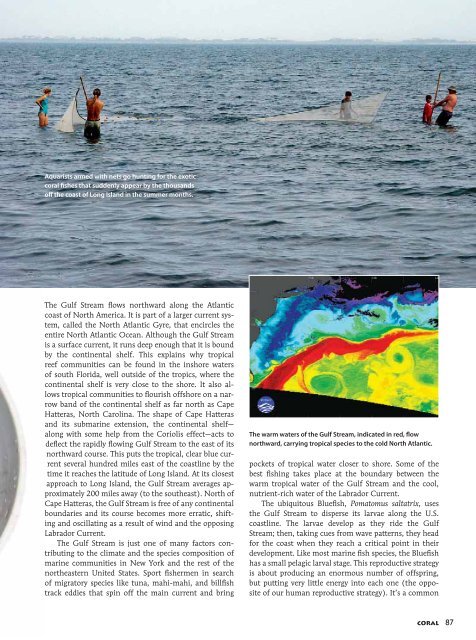Create successful ePaper yourself
Turn your PDF publications into a flip-book with our unique Google optimized e-Paper software.
Aquarists armed with nets go hunting for the exotic<br />
coral fishes that suddenly appear by the thousands<br />
off the coast of Long Island in the summer months.<br />
The Gulf Stream flows northward along the Atlantic<br />
coast of North America. It is part of a larger current system,<br />
called the North Atlantic Gyre, that encircles the<br />
entire North Atlantic Ocean. Although the Gulf Stream<br />
is a surface current, it runs deep enough that it is bound<br />
by the continental shelf. This explains why tropical<br />
reef communities can be found in the inshore waters<br />
of south Florida, well outside of the tropics, where the<br />
continental shelf is very close to the shore. It also allows<br />
tropical communities to flourish offshore on a narrow<br />
band of the continental shelf as far north as Cape<br />
Hatteras, North Carolina. The shape of Cape Hatteras<br />
and its submarine extension, the continental shelf—<br />
along with some help from the Coriolis effect—acts to<br />
deflect the rapidly flowing Gulf Stream to the east of its<br />
northward course. This puts the tropical, clear blue current<br />
several hundred miles east of the coastline by the<br />
time it reaches the latitude of Long Island. At its closest<br />
approach to Long Island, the Gulf Stream averages approximately<br />
200 miles away (to the southeast). North of<br />
Cape Hatteras, the Gulf Stream is free of any continental<br />
boundaries and its course becomes more erratic, shifting<br />
and oscillating as a result of wind and the opposing<br />
Labrador Current.<br />
The Gulf Stream is just one of many factors contributing<br />
to the climate and the species composition of<br />
marine communities in New York and the rest of the<br />
northeastern United States. Sport fishermen in search<br />
of migratory species like tuna, mahi-mahi, and billfish<br />
track eddies that spin off the main current and bring<br />
The warm waters of the Gulf Stream, indicated in red, flow<br />
northward, carrying tropical species to the cold North Atlantic.<br />
pockets of tropical water closer to shore. Some of the<br />
best fishing takes place at the boundary between the<br />
warm tropical water of the Gulf Stream and the cool,<br />
nutrient-rich water of the Labrador Current.<br />
The ubiquitous Bluefish, Pomatomus saltatrix, uses<br />
the Gulf Stream to disperse its larvae along the U.S.<br />
coastline. The larvae develop as they ride the Gulf<br />
Stream; then, taking cues from wave patterns, they head<br />
for the coast when they reach a critical point in their<br />
development. Like most marine fish species, the Bluefish<br />
has a small pelagic larval stage. This reproductive strategy<br />
is about producing an enormous number of offspring,<br />
but putting very little energy into each one (the opposite<br />
of our human reproductive strategy). It’s a common<br />
CORAL<br />
87

















